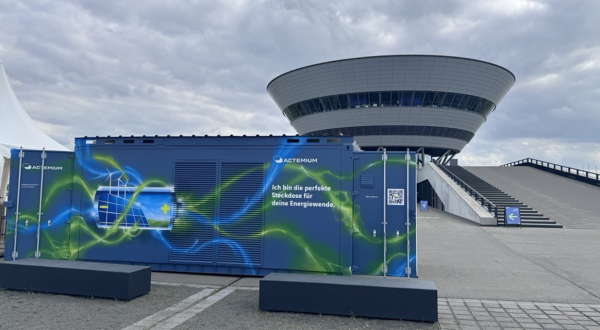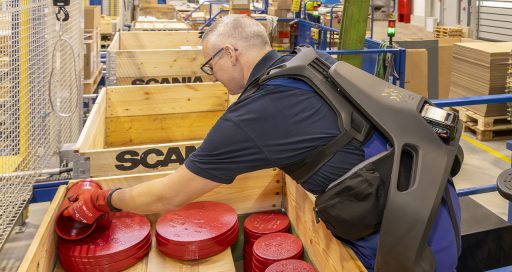The use of mobile robotics in industrial settings is developing rapidly. Private 4G/5G networks are a fast-maturing solution to ensure a reliable, robust connection on complex sites. We look at some examples with Axians, from the Port of Rotterdam to the Mercedes-Benz head office in France.

Private industrial 5G provides a reliable, low-latency connection for robotics applications on all types of industrial sites and improves on the limited range of uses offered by other technologies: “Wi-Fi has limited power and requires access points every 30 m,” explains Yann Bertrand, International Business Development Manager at Axians, the VINCI Energies ICT brand. “This complicates installations, especially outdoors when networking large sites in complex environments – a petrochemical or steel-making plant, for example. 5G provides reliable, robust coverage with very few base stations.”
“Wi-Fi also has clear limitations in mobile situations,” he adds. We are now seeing increasing use of mobile robots in factories, where even a temporary interruption in connectivity can seriously hamper the industrial process. Using 5G avoids this type of incident.”
The predictable nature of 5G’s performance as a reliable mobile broadband connection therefore makes it a real asset in an industrial setting. For the past four years, several container terminals at the Port of Rotterdam have been equipped with a private mobile network, designed and installed by Axians, to connect their autonomous vehicles, which transport the containers unloaded from ships to their designated storage areas.
“With Wi-Fi, the system frequently experienced dropped connections, which caused the vehicles to stop dead,” says Yann Bertrand. “Given the €100,000 cost of an hour’s stoppage, the port had no hesitation in adopting 4G, and soon, 5G.”
More recently, in the Port of Bordeaux, the port terminal operator Sea‑Invest had a 4G antenna installed to improve site-wide reliability of the connections to computers on board its cranes and user-operated container vehicles.
Take-off
“In the field of robotics,” says Yann Bertrand, “the rollout of private 4G/5G networks is still in its infancy. It required a long period of evangelism, and the price drop that accompanied the release of versions adapted to industrial needs. But in 2024, the market, especially for 4G, is really taking off. The 5G technology is not yet mature, but new use cases are being developed.”
In 2022, the robot and automated solution builder Omron appointed Nokia, in partnership with Axians for the engineering and installation, to install 5G at its factory in Argonay, near Annecy in Haute‑Savoie, with a view to trialling the development of robots capable of operating via a private 5G network.
“In the field of robotics, the rollout of private 4G/5G networks is still in its infancy.”
In 2023, at Star Center, the Mercedes‑Benz headquarters in Montigny‑le‑Bretonneux, west of Paris, the German carmaker has implemented a novel use case. To avoid having to install electric charging stations for every space in its underground parking area, the group opted for autonomous robots. The robots are connected to a private 4G network with one antenna covering the entire parking area, and move to plug themselves directly into vehicles that need charging.
Robotisation and virtualisation
A wealth of new uses is emerging from the rollout of private 4G/5G networks. Axians has therefore forged links with an R&D programme financed by Bpifrance, which among others includes the Stellantis group, and manufacturers of connected tools such as Miodex, which specialises in screw assembly solutions.
“With 5G, the aim is to be able to locate objects to within 50 cm, and eventually 10 cm,” says Yann Bertrand. “This will allow better quality tracking by verifying that the work has been done in the right place and in the right way, and make it possible to block the use of tools not appropriate for a given workstation.”
This kind of application is in particular demand in the aerospace sector. Yann Bertrand explains that “Airbus has private mobile networks on its production sites to provide connectivity everywhere, even to the tip of an aircraft wing on the assembly line.”
The Actemium expert concludes that upcoming developments in the virtualisation of automated systems, which separates the physical machine from its software and operating systems to allow remote updates, maintenance and repair (robot-as-a-service), will only increase the need for a fast, reliable connection.
p5G4OT – the private 5G mobile robot
In 2021, Actemium and Axians, the VINCI Energies industry and ICT brands, launched a PoC (proof of concept) for creating a robust, reliable mobile industrial robot capable of data capture both indoors and outdoors. “On some of our projects, we used to experience latency issues from time to time,” explains Frédéric Boulvert, Business Innovation Engineer at Actemium Rennes, who also coordinates the Actemium Robotics Club’s advanced industrial robotics working group. “So, we approached Axians, which was already working on applications for private mobile networks in industrial settings. And the result was p5G4OT, which stands for “private 5G for Operational Technology”. This demonstrator can load and unload industrial parts or other products anywhere on site with no loss of connectivity, thanks to the installation of a private 5G network. Frédéric Boulvert adds that “This type of configuration particularly comes into its own when you are using robots equipped with AI vision systems, where the transmission of images cannot be interrupted due to a lost connection,” and also emphasises the data security benefits of a private 5G network: “The data is basically being generated directly on site via a central server”. p5G4OT has been undergoing testing in an industrial setting throughout summer 2024.
10/17/2024





